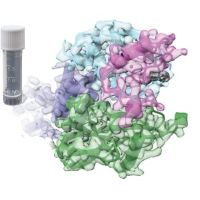Specification
| Description | Recombinant protein from the full-length sequence of Homo sapiens CTD small phosphatase 1 (CTDSP1), transcript variant 1 (NM_021198). |
| Organism | Homo sapiens (Human) |
| Expression Host | Human Cells |
| Tag Info | His or DYKDDDDK. Please contact us if you need further information or require specific designed tag. |
| Purity | Greater than 90% by SDS-PAGE gel |
| Uniprot ID | Q9GZU7 |
| Entry Name | CTDS1_HUMAN |
| Gene Names | CTDSP1 NIF3 NLIIF SCP1 |
| Alternative Gene Names | NIF3 NLIIF SCP1 |
| Alternative Protein Names | Carboxy-terminal domain RNA polymerase II polypeptide A small phosphatase 1 (EC 3.1.3.16) (Nuclear LIM interactor-interacting factor 3) (NLI-IF) (NLI-interacting factor 3) (Small C-terminal domain phosphatase 1) (SCP1) (Small CTD phosphatase 1) |
| Application | Antigens, Western, ELISA and other in vitro binding or in vivo functional assays, and protein-protein interaction studies; For research & development use only! |
| Buffer | Purified protein formulated in a sterile solution of PBS buffer, pH7.2, without any preservatives |
| Endotoxin | Endotoxin level is < 0.1 ng/µg of protein (<1EU /µg) |
| Length | 261 |
| Molecular Weight(Da) | 29203 |
| Protein Sequence | (The sequence of expressed protein may have some variation from the sequence shown below. Please contact us for the exact sequence.) MDSSAVITQISKEEARGPLRGKGDQKSAASQKPRSRGILHSLFCCVCRDDGEALPAHSGAPLLVEENGAIPKQTPVQYLLPEAKAQDSDKICVVIDLDETLVHSSFKPVNNADFIIPVEIDGVVHQVYVLKRPHVDEFLQRMGELFECVLFTASLAKYADPVADLLDKWGAFRARLFRESCVFHRGNYVKDLSRLGRDLRRVLILDNSPASYVFHPDNAVPVASWFDNMSDTELHDLLPFFEQLSRVDDVYSVLRQPRPGS |
Background
| Function | FUNCTION: Preferentially catalyzes the dephosphorylation of 'Ser-5' within the tandem 7 residue repeats in the C-terminal domain (CTD) of the largest RNA polymerase II subunit POLR2A. Negatively regulates RNA polymerase II transcription, possibly by controlling the transition from initiation/capping to processive transcript elongation. Recruited by REST to neuronal genes that contain RE-1 elements, leading to neuronal gene silencing in non-neuronal cells. {ECO:0000269|PubMed:12721286, ECO:0000269|PubMed:15681389}. |
| Pathway | |
| Protein Families | |
| Tissue Specificity | Expression is restricted to non-neuronal tissues. Highest expression in skeletal muscle, spleen, lung and placenta. {ECO:0000269|PubMed:15681389}. |
QC Data
| Note | Please contact us for QC Data |
| Product Image (Reference Only) |  |

